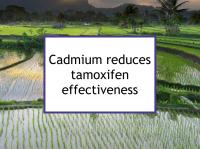Cadmium is an estrogenic heavy metal (a metalloestrogen) with no beneficial effects on health. It functions as an endocrine disruptor, stimulating estrogen receptor (ER) activity. Since the body does not readily eliminate it, cadmium accumulates in tissues. Cadmium exposure has been linked to increased breast cancer risk.
Breast cancer patients tend to have higher levels of cadmium in their breast tissue than cancer-free women. Cadmium is associated with increased breast density, a strong breast cancer risk factor. Cadmium has been shown to promote uterine and mammary gland growth in mice. Numerous studies have demonstrated that cadmium increases the growth and proliferation of breast cancer cells. Cadmium exposure has also been linked to increased risk of breast cancer in epidemiological studies, although not all studies have reported an association.
Cadmium has been shown to interfere with the treatment effects of aromatase inhibitors and 5-fluorouracil (5-FU) chemotherapy in hormone receptor positive (ER+/PR+) breast cancer cells. Now a new study has reported that cadmium also appears to reduce the effectiveness of tamoxifen treatment.
Non-dietary sources of cadmium exposure
Cadmium is easily absorbed through the lungs, less easily absorbed in the digestive tract, and difficult to absorb through the skin. Cadmium is released into the environment from numerous types of mining, metal smelting, manufacturing and waste disposal operations. People living near or working for such facilities might be exposed to relatively high levels of cadmium in the air. Cadmium is also found in vehicle exhaust, leading to potentially high levels of cadmium in soils near roads. Cigarettes are also a possible source of significant cadmium exposure.
Dietary sources of cadmium
Diet is the primary source of cadmium exposure for most U.S. women. Both developed and less developed countries have problems with cadmium contamination of coastal waters, leading to potentially high levels in shellfish. In addition, there are large areas of some countries, including the U.S., Canada and China, in which significant levels of cadmium are found naturally in the soil. Certain plants take up and incorporate cadmium more readily than others. Included are rice and other cereal grains, flaxseed, potatoes, sunflowers, peanuts, spinach and other leafy vegetables, and tobacco. Generally speaking, cooking is not effective in reducing cadmium concentrations in food.
Most U.S. women can limit their cadmium exposure by avoiding all but modest consumption of the following foods:
- Dried apricots from Turkey
- Dark chocolate
- Free range escargot snails
- Flaxseed produced in high-cadmium regions
- Indian mustard (black mustard) imported from the old Soviet Union, India or China.
- Rice produced in Louisiana, Thailand or India
- Shellfish
- Sunflower seeds
Latest research finds cadmium interferes with tamoxifen treatment
The study referenced above was designed to investigate the relationship between environmental exposure to cadmium and the Warburg effect in breast cancer, thereby explaining cadmium's possible interference with breast cancer treatment. The authors also examined the influence of cadmium on treatment with tamoxifen.
The Warburg effect is a form of deviant energetic metabolism whereby the rate of glucose uptake is significantly increased. Together with activation of key proliferative and survival signaling pathways, the Warburg effect plays a critical role in tumorigenesis, suggesting that compounds targeting key proteins involved in the Warburg effect could act as cancer treatment.
The authors performed an observational study, using two groups of breast cancer patients, which found a link between urinary cadmium levels and tumor expression of HIF1A (a key regulator of the Warburg effect). However, further studies using ER+/PR+ MCF-7 breast cancer cells failed to confirm that cadmium exposure had an influence on molecular and biochemical markers of the Warburg effect.
On the other hand, long-term exposure to a low and environmentally relevant concentration of cadmium led to its accumulation in ER+/PR+ cells and reduced their sensitivity to tamoxifen. The authors conclude that an association between cadmium and the Warburg effect was suggested in their observational study, while not confirmed in cell studies. However cadmium appears to interfere with tamoxifen treatment, a finding which deserves further study since it implies resistance to hormone therapy.
Please see our articles on tamoxifen and cadmium and breast cancer for more information.
